Panagor 55mm f/3 Macro Lens Review
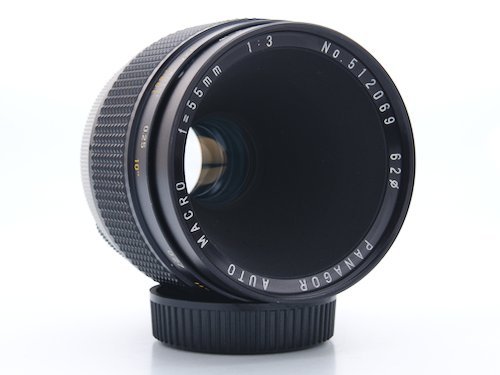
Panagor was a brand name used by Jaca Corporation in the UK, Europe, and Asia. Jaca distributed re-branded photography gear manufactured by other companies. The Panagor 55mm f/3 macro lens was made by Komine.
Used Prices and Where to Buy
If you’re in the US, don’t bother looking for a Panagor version. The Panagor brand was marketed throughout Europe. The Vivitar version can actually be found.
Affiliate Advertising Disclosure
Outside the Shot is a participant in the Amazon Services LLC Associates Program, an affiliate advertising program designed to provide a means for sites to earn advertising fees by advertising and linking to Amazon.com.
As an eBay Partner, I may be compensated if you make a purchase. I also participate in affiliate advertising programs with KEH and Adorama. More can be found on the Affiliate Discolsure page.
Even if you can find the lens, you shouldn’t buy it. Instead look for the second version, the Vivitar 55mm f/2.8 on ebay.
Quantaray (Ritz Camera brand) versions must not have sold well because they rarely show up for sale. Elicar is another brand marketed in Europe.
The Vivitar version ranges in price from $40-$80. Make sure the serial number starts with 28 as that designates that the lens was made by Komine. There should be several different lens mounts available.
Comparable Lenses
- Vivitar 55mm f/2.8
- Micro Nikkor 55mm f/3.5 PC
- Olympus OM-System 50mm 3.5 Auto-Macro
- Canon FD 50mm f/3.5 Macro
Quick Thoughts on the Lens
Wide-open the lens is the worst macro lens I’ve ever seen. The corners are terrible. It is so bad that I think something might be wrong with the lens. Stopped down to f/5.6, the quality is greatly improved. At f/8 the lens is quite good.
The lens has a flat field of view. There isn’t obvious amounts of distortion, but I would guess a small amount would show up if images were analyzed.
It is usable for macro and closeup photography, but wouldn’t be my choice for a walk around lens. I also wouldn’t suggest seeking the lens out as the second, f/2.8, version of the lens is superior.
Lens Specs
| Manufacturer | Komine |
| Made in | Japan |
| Year Released | 19?? |
| Original Price | $???.?? |
| Version | Panagor f/3 |
| Elements Groups | 5 ele. 4 gr. |
| Focal Length | 55mm |
| Aperture | f/3-16 |
| # Aperture Blades | 6 |
| Aperture control | Manual, Manual/Auto Diaphragm |
| Focus type | Manual |
| Hard infinity stop | Yes |
| Magnification | 1:1 |
| Minimum Focus Distance | 25cm (10”) |
| Working Distance | 5.2cm (2-1/16") |
| Filter Threads | 62mm |
| Weight | 318g (11.2oz) |
| Dimensions | ⌀70mm x 76mm (2.75" x 3") |
Lens Versions
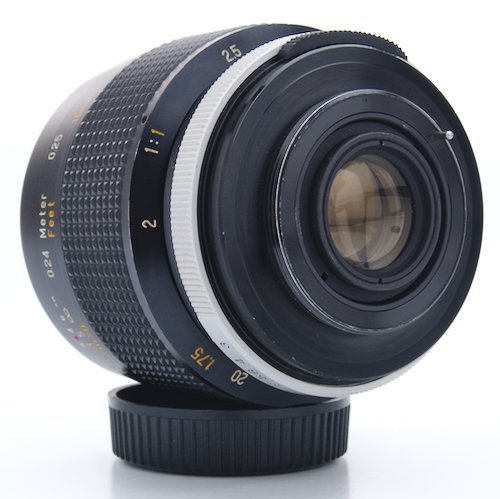
This lens was manufactured by Komine and branded by other companies for sale.
There are two versions with the first being f/3 and the second is f/2.8. The Vivitar 55mm f/2.8 is the most well know second version of the lens.
Versions of the lenses can be found with different brand names and mounts. Information on brand names is hard to come by because the distribution companies went out of business or were sold. The mounts are not specific to any of the brand names.
| Mounts | Brand Names |
|---|---|
| Pentax M42 | Panagor |
| Pentax K | Vivitar |
| Nikon F | Quantaray |
| Canon FD | Elicar |
| Minolta MD | Spiratone |
| Olympus OM | Rokunar? |
There is a 55mm f/2.8 macro lens under the Sears & Soligor branding. The cosmetic differences are larger than those seen in the brands listed in the table above. While I have found information online claiming these to be made by Komine, I am not convinced.
Sources
Camera-Wiki: http://camera-wiki.org/wiki/Jaca_Corporation
Build Quality, Design, and Sample Variation
I have the Vivitar 55mm f/2.8 lens to compare the Panagor against. The Vivitar is better across the board. Despite looking the same, and not believing that the Vivitar is actually an f/2.8, there might be differences.
I think something might be wrong with the Panagor I have. Though the elements could be made from different glass or have improved coatings.
Komine made lenses on a contract basis. My concern is what decisions were made to keep the cost of the lens below first-party manufactures.
I am concerned that quality control from the factory might not have been good and internal parts may be susceptible to damage that will hurt optical quality.
The aperture sizes are different between the Panagor and Vivitar. For any given aperture, the Panagor’s aperture is slightly larger.
I don’t know if it is due to sample variation or if there are optical differences between the lenses.
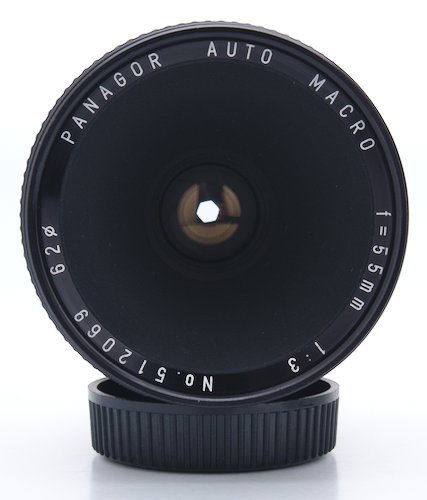
I am able to rock the front half of the lens around and make some noise. I wonder if a screw is loose or there is another internal issue.
The Vivitar does not have this issue. However, the grease in the Vivitar is starting to dry out and the focus ring is tight. The focus ring on the Panagor turns smoothly.
The Panagor goes to 1:1 magnification without the need for an extension tube. This is different from other vintage macro lenses in the 50mm-60mm range.
The focus ring has about 700° of rotation. It feels like it is never going to stop turning.
There is an auto/manual switch for the aperture. Some adapters will have a lip to depress the aperture pin and others won’t. This is a feature that prevents compatibility issues with M42 adapters.
Testing setup
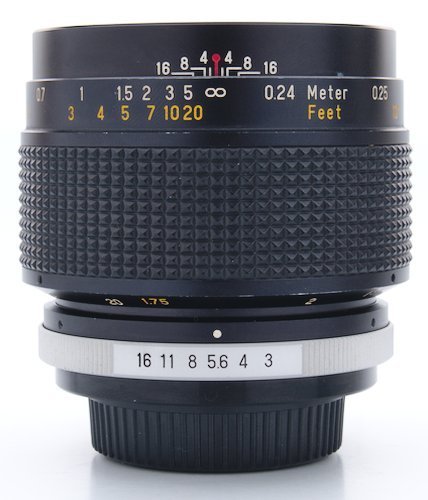
Sony A7 with a cheap adapter. Reversing the lens was done on a Nikon PB-4 bellows with a D750 camera.
Usage & Working Distance
At 1:1 you’ll get about 2 inches (5cm) of working distance from the front of the lens to the subject. That small amount of working distance can make lighting difficult.
Needing to be that close can cause small animals to flee. Macro lenses with 90mm-105mm focal lengths have a longer and more usable working distance at 1:1. I avoid using standard length macro lenses for 1:1 magnification.
Where the Panagor performs well is for closeup photography. I like the focal length for tabletop, copy, and vertical shots. Getting a page, plate, or other tabletop sized object to fill the frame doesn’t require moving back several feet.
When going vertical I like that I don’t have to get a ladder to setup the shot. Then there is the benefit of being able to move in close for detailed shots without having to change lenses.
Test Shot Sharpness Comparison
- f/3 - Mediocre in the center with a fast fall off to very bad corners. The worst performance wide open out of any macro lens I have tested.
- f/4 - Better in the center and corners. The corners are still very soft.
- f/5.6 - A huge improvement. Everything is much sharper.
- f/8 - Very similar to f/5.6 with the outer edges of the corners become a little sharper. This is the sharpest aperture.
- f/11 - A larger depth of field at the cost of some softness due to diffraction.
- f/16 - Diffraction is very apparent.
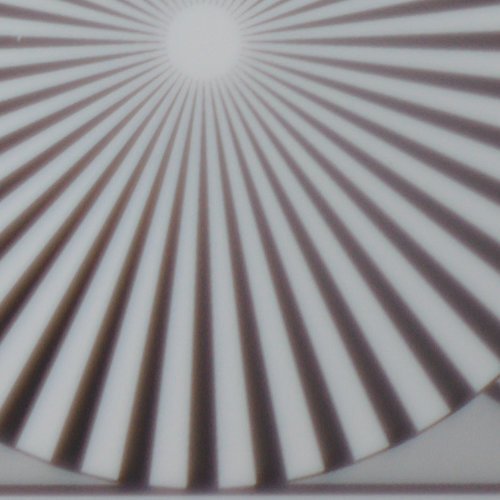
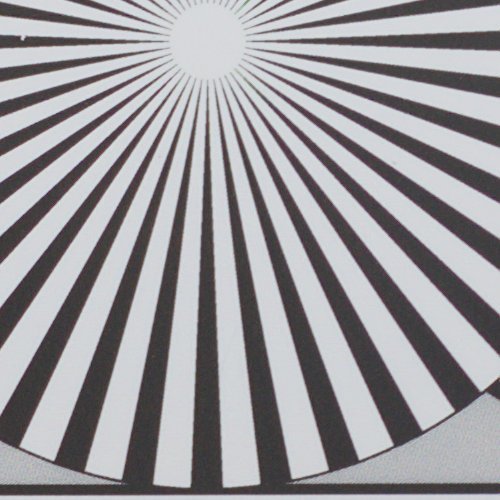
Magnification by Extension & Reversal
To test the lens I had to use a 62mm to 58mm step down ring connected to a 58mm to 52mm step down ring, which was then screwed into the Nikon BR-2A.
Not an ideal setup and since then I have received a Nikon BR-5, which is a 62mm to 52mm step down ring. The BR-5 isn’t worth the $20 I payed, a generic step down ring would have been better.
Reversed the lens worked better than I was expecting. Thanks to the auto/manual switch, changing the aperture didn’t require an extra adapter to close down the diaphragm.
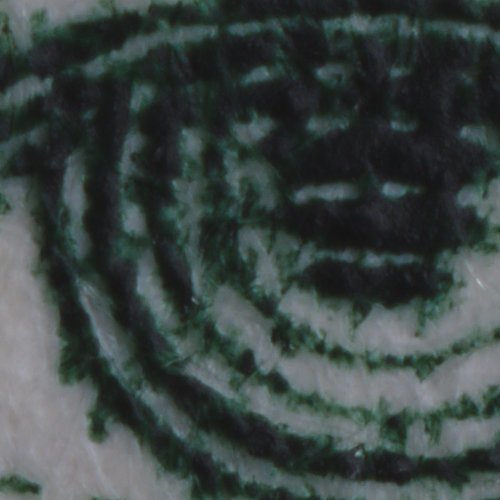
Conclusion
An f/3 version of the lens is not worth trying to track down.
The f/2.8 versions are easier to find and perform better. Out of all the standard focal length macro lenses I’ve tried, the Vivitar 55mm f/2.8 is my favorite.